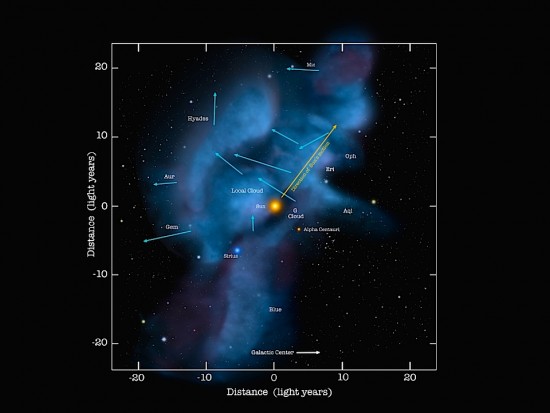
The local interstellar cloud as astronomers believe it to be. Credit: NASA/Goddard/Adler/U. Chicago/Wesleyan
Aug 18, 2014
Charged plasma surrounds the Solar System.
Electric Sun theory presupposes that the Sun is a glowing anode, or positively charged electrode. Its oppositely charged cathode is invisible, a “virtual cathode,” called the heliosphere that exists billions of kilometers from its surface, where a “double layer” isolates the Sun’s plasma cell from the galactic plasma that surrounds it. Galactic plasma is otherwise called the Interstellar Medium (ISM).
Electric forces work within a double charge layer above the Sun’s surface, generating active plasma phenomena that are seen by orbiting solar probes, as well as ground-based instruments. Celestial bodies interact through conductive plasma and are connected by circuits, so the Sun is also assumed to be electrically connected with the galaxy.
The Sun can be thought of as an unstable electrically charged object seeking equilibrium with its environment. Charges flowing into and out of the Sun can sometimes increase to the point where it releases plasma discharges called solar flares. Conventional scientists think that solar flares, and their associated coronal mass ejections (CME), are caused by magnetic loops “reconnecting” with each other, causing a short circuit. Magnetic reconnection is a poorly constructed theory, but it is the only explanation offered by heliophysicists.
A dark mode plasma emission is constantly radiating from the Sun, traveling through the Solar System at a speed of 700 kilometers per second when it is at its most energetic. In a gravity-dominated Universe, solar radiation pressure cannot explain how charged particles from the Sun accelerate past Venus, Earth and the rest of the planets. Prior to the solar wind’s discovery, no one expected such acceleration.
Electric Universe proponents think that there is an obvious explanation: electric fields in space. Coherent electric charges flow through the Solar System, so it is reasonable to conclude that dark mode solar plasma is affected by electrodynamic fields. Since the circuit that connects the Sun with the Milky Way extends for hundreds of thousands of light-years, electrical energy is probably constrained by magnetically confined Birkeland currents, providing power to the solar anode.
An Electric Sun creates flares, the hot corona, and all other solar phenomena because it responds to changes in electrical input from our galaxy. Birkeland current filaments electrify the Solar System, supplying more or less power to the Sun as they oscillate in power output. Arc mode, glow mode, and dark mode discharges are all influenced by those flowing electric charges.
These ideas most likely hold the reason for what scientists call the “local hot bubble” (LHB) that surrounds the Solar System. A recent press release states that detectors have located a field of “million-degree interstellar plasma” that initiates an X-ray glow “over the entire sky”.
NASA astrophysicists found that the X-ray background is radiating most strongly in the plane of the Milky Way. According to their theories, it is in that region where X-rays ought to be absorbed. As Massimiliano Galeazzi from the University of Miami in Coral Gables, Florida stated: “This is a significant discovery. Specifically, the existence or nonexistence of the local bubble affects our understanding of the area of the galaxy close to the sun, and can, therefore, be used as a foundation for future models of the galaxy structure.”
Electric Universe theory has already presented information that can partially explain galactic structure and its influence on the Solar System.
Stephen Smith












